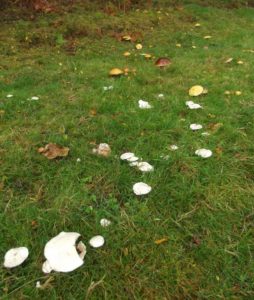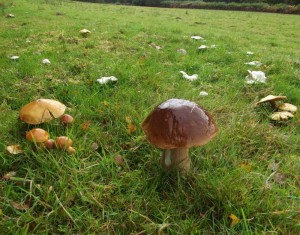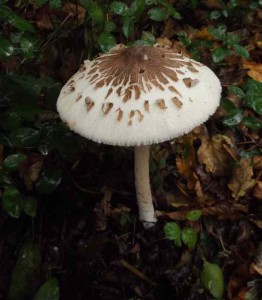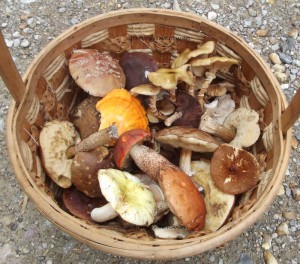Email: geoffdann@hotmail.com
Phone: 07964 569715
19/09/2016
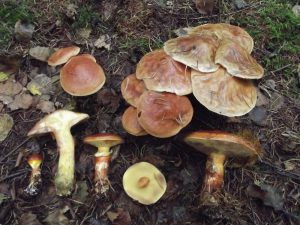
Larch Bolete (19/09/2015, south-east Sussex)
Given the length of time that mycologists and foragers have been watching fungi, you might think we would have a pretty good idea if there’s going to be a good year or a bad year and be able to predict what they are going to do. If so, you’d be wrong. This is actually part II of the mysterious case of the missing mushrooms – part I was the second half of last autumn. In that case what happened was an extended dry spell from mid-September to late October. That this led to a lack of fungi isn’t remotely mysterious; fungi need moisture or they cannot produce fruit bodies. The mystery was their total failure to recover when the rains finally came. I expected November 2015 to make up for the disappointing October, but the situation actually got worse, and by the end of November there was nothing to be found, even though the usual season-ending hard frost hadn’t happened. My most successful outing of last autumn was exactly one year ago: September 19th 2015. Today I returned to the precise locations I visted that day and I found sweet fanny adams. And it is not just some species that are missing; it’s almost everything apart from a few wood-consuming bracket fungi like Giant Polypore and Beefsteak Fungus. This is particularly strange, since last year’s poor showing might have been expected to be followed by a bumper harvest this year. A further element of strangeness is a geographical inconsistency – in the northern half of Britain there is a completely different story unfolding. Judging by the photos and the words of mouth, the start to the mushroom season in Scotland and northern England is at least average and in some places very good indeed.
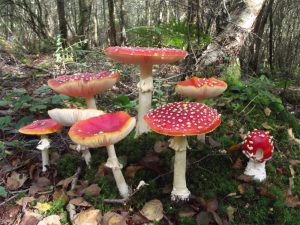
Fly Agaric (19/09/2015, south-east Sussex)
I won’t pretend that I know what is going on, but my best guess is that it is a combination of temperature and soil moisture. We’ve just had the highest September temperatures for over a century, and my home territory lies just on the border of what botanists call “hardiness zone 9”. Most of the UK is in the colder zone 8, but the south west and the areas immediately adjacent to the south and west coasts of Britain are warmer. This is due to the sea acting as a temperature buffer: daytime highs are slightly lower and nighttime lows are slighty higher. The result is that while the average lows further north have fallen below the level that triggers most of the autumn fungi to fruit, in the far south the fungi still think it is summer. Although it is more complicated than that, because what I’ve been seeing over the past two weeks is one fruit body here and there – one Deathcap, one Blusher, or as today, one Scarletina Bolete (spotted from the car, growing by the side of a road). This suggests that soil moisture content is also playing a part, even though we have had a reasonable amount of rain recently. I won’t pretend that I know what is going to happen next either, but my best guess is that it is just taking a while for the fungi to respond to recent temperature falls and heavy rain, and that within a week or two there will be fungi all over the place. I certainly hope so, because I have got a busy October ahead of me.
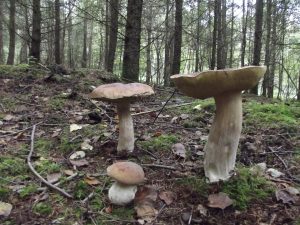
Penny Bun / Cep (19/09/2015, south-east Sussex)
Speaking of which, it is probably worth reminding people of some important dates and events which still have free spaces.
Firstly, I have just added another extra date to my fungi foraging sessions in Hemsted Forest (west Kent), due to the others being booked up. This will be on Saturday November 5th (see fungi foraging link at the top of the page).
There are still places available on the fungi foraging workshops on Sat/Sun 8th/9th of October at Bay Tree Cottage in Northamptonshire, and the fungi foraging day and chef-prepared meal on Sun 16th of October at Catthorpe Manor in Leicestershire.
There will be a book launch event (free) on Sat Oct 22nd at Bookbuster, Queen’s Road, Hastings. This will include talks at 6pm and 7.15pm, and signed copies of the new book will be on sale.
There will be another launch event on Fri Nov 4th at The Garden House in Brighton, East Sussex. The launch event will include a display of a wide variety of fungi, signed copies of the book will be available, and it is followed by a talk, a tasting session and a meal (see their website for details).

